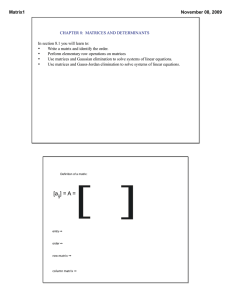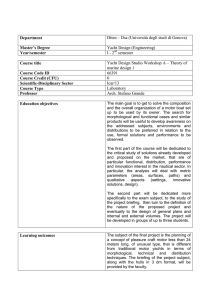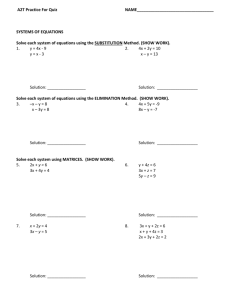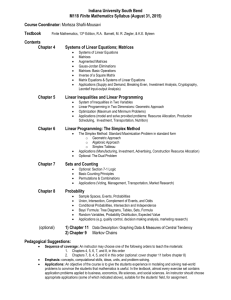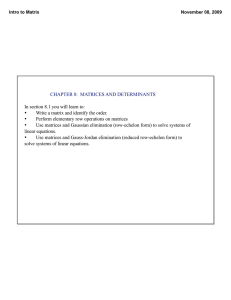Exam I Review Problems
advertisement
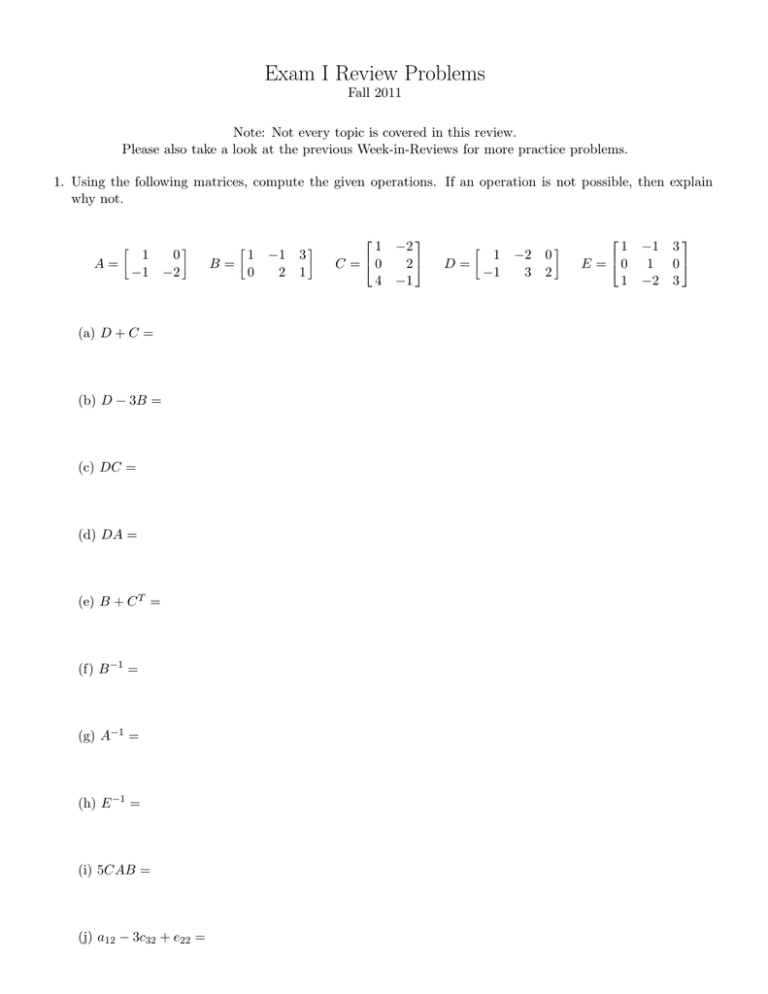
Exam I Review Problems Fall 2011 Note: Not every topic is covered in this review. Please also take a look at the previous Week-in-Reviews for more practice problems. 1. Using the following matrices, compute the given operations. If an operation is not possible, then explain why not. 1 0 A= −1 −2 (a) D + C = (b) D − 3B = (c) DC = (d) DA = (e) B + C T = (f) B −1 = (g) A−1 = (h) E −1 = (i) 5CAB = (j) a12 − 3c32 + e22 = 1 B= 0 −1 3 2 1 1 −2 C = 0 2 4 −1 1 −2 0 D= −1 3 2 1 E = 0 1 −1 3 1 0 −2 3 2. Solve for the variables x, y, z, and u. If this is not possible, then explain why not. " 1 −1 0 −2 #" −2x 0 3 4 # −3 " (y − 1) x 4 (2z + 1) # = " −7 −2u −10 8 #T 3. Find the matrix K that makes the following true. If this is not possible, then explain why. 0 7 3 7 0 2 0 0 8 1 1 −6 0 + K 5 2 0 = 0 1 2 3 7 6 6 1 0 1 6 4 0 4. Use the following matrices to determine which of the products below make sense. Bolli Bros. and Pizza Nut are two restaurants which each sell pizza rolls (in batches of 6 rolls), calzones and orders of cheese sticks. The prep and cook times for each food item is given, as well as the number of items two school districts will order. BolliBros. P izzaN ut P izzaRolls $5.95 $8.00 $6.95 $9.99 A = Calzone CheeseSticks $3.95 $6.99 B= P repT ime(M in) CookT ime(M in) " P izzaRolls 5 6 BISD P izzaRolls 100 C = Calzone 75 CheeseSticks 50 (a) AB (b) BA (c) BC Calzone CheeseSticks # 3 2 7 6 CSISD 85 100 60 5. An investor has $50,000 he invests into three accounts yielding 2%, 8%, and 4% interest/year, respectively. If he earns a total of $4,000 interest in one year, and if he invests twice as much at 4% as he does at 2%, how much does he invest in each account? (a) Set up a system of equations representing this problem. (b) Write your system of equations as a matrix equation, AX = B. (c) Solve your matrix equation by using matrix inverses. (d) Solve your system of equations by using an augmented matrix. 6. Find the equation of the line that passes through the y-intercept of the line 4x + 2y = 7 and also passes through the x-intercept of the line y = 9x + 8. 7. Find the value of m that makes the following lines parallel. Verify that you will have two distinct lines. 3x − 7y = −10 8x + my = 15 8. A sailor buys a yacht for $1,000,000. After 10 years it is worth $800,000. (a) Assuming the yacht is depreciating linearly, find the value of the yacht as a function of the number of years the sailor has owned it. (b) Assuming a scrap value of $0, how long will the yacht have value? 9. A company making blankets incurs a total cost of $3375 when producing 250 blankets and a total cost of $3750 when producing 300 blankets. The company sells the blankets for $20 each. (a) What are the fixed costs for this company? (b) Find the company’s linear profit function. (c) What is the break-even point for this company? 10. Given two functions 3x − 11p + 45 = 0 and 2x + 7p − 56 = 0, where x represents the number of items made/sold and p represents the price of the item, what are the equilibrium price and equilibrium quantity which would satisfy both consumers and producers? 11. The following data are representative of information in Energy Policy, March 1983. The data represents carbon dioxide (CO2 ) emissions from coal-fired boilers (in units of 1000 tons) over a period of years between 1965 and 1977. For this problem let the time start with zero in 1965.(i.e. 1965 is zero) Year(x) CO2 emission (y) 0 910 5 680 8 520 9 450 10 370 11 380 12 340 (a) Determine the equation of the least-squares line for this data. Round all coefficients/constants to 4 decimal places. (b) Is the line you found a good fit for the data? Why or why not? (c) Predict the carbon dioxide emissions in the year 1972, to the nearest ton. (d) In what year would we expect to have carbon dioxide emissions of 200,000 tons? 12. Are the following augmented matrices in reduced row-echelon form? If YES, how many solutions will the system have? If NO, explain which property is violated. (a) " 1 0 2 4 0 1 3 5 # 0 1 0 1 (b) 0 0 1 2 0 0 0 0 1 2 3 10 (c) 0 1 0 15 0 0 0 0 1 0 2 (d) 0 1 5 0 0 1 1 0 0 7 (e) 0 0 1 8 0 1 0 9 (f) " 1 3 100 0 −1 200 1 0 0 0 (g) 0 1 0 0 0 5 0 6 1 18 0 0 # 13. (a) Use the Gauss-Jordan Elimination Method (showing all row operations and intermediate matrices) to # " 2 15 50 find the equivalent reduced row-echelon form for the following: −3 7 20 (b) Check your answer to part (a) by using rref on your calculator. 14. Solve the following systems of equations. (a) −2x + 5y − 3z = 30 x − y − 2z = 50 x − 7y + 12z = −210 (b) 20x − 15y = 70 x−y =2 −8x + 3y = −30 15. A company makes two types of toys: zappers and wompers. Each zapper takes 5 oz. of plastic and 4 minutes to manufacture. Each womper takes 3 oz. of plastic and 2 minutes to manufacture. There is available 5250 oz. of plastic and 60 hours of manufacturing time. If the company makes a total of 1650 toys and all resources are to be used, determine how many of each toy the company can make.

